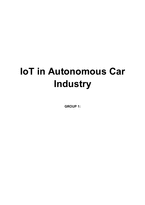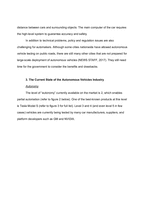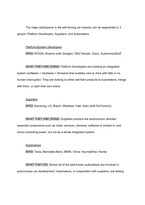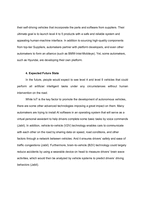GROUP 1:
The Origin of IoT in Autonomous Vehicle Industry
The origin of IoT usage within vehicle industry date back in early 1958, where the idea of the self-driving car became prominent (Ninan, Simon, et al). It was not until 1995 during the embedded era that different auto companies started exploring the connectivity aspect of the car and the roads, for instance, GM OnStar. But the idea was never implemented because of its capital-intensive involvement, lack of competition and use cases at the time. The first experience of true IoT was seen during infotainment era which ranges from 2007 to 2012 (refer to figure 1 below). During this era, the car technology such as Ford Sync and GM Mylink took advantage of wireless connectivity aspect which was enabled by the wireless IoT technology. It was at this time the IoT usage in connecting autonomous car through smart cities and different car networks became prevalent. The image below highlights the key eras where the IoT experienced an exponential growth until today.
2. Challenge and Risk
Today’s automakers are still facing fierce competition and challenges. Essentially, an autonomous car needs to replace a human driver from three aspects: perception, computing and control (Tim Menke, 2017). The technology to complete these tasks is achieved through several kinds of high-tech devices, including cameras, radars and computers. Cameras and radars can receive photos and sounds while computers will integrate all the information and hand out instructions to control electronics just as human brains do.
However, these high-tech devices have some risks. For example, cameras perform well in identifying shapes and colors, but they are bad at calculating the distance between cars and surrounding objects. The main computer of the car requires the high-level system to guarantee accuracy and safety.
In addition to technical problems, policy and regulation issues are also challenging for automakers. Although some cities nationwide have allowed autonomous vehicle testing on public roads, there are still many other cities that are not prepared for large-scale deployment of autonomous vehicles (NEWS STAFF, 2017). They still need time for the government to consider the benefits and drawbacks.
3. The Current State of the Autonomous Vehicles Industry
Autonomy
The level of “autonomy” currently available on the market is 2, which enables partial automation (refer to figure 2 below). One of the best-known products at this level is Tesla Model S (refer to figure 3 for full list). Level 3 and 4 (and even level 5 in few cases) vehicles are currently being tested by many car manufacturers, suppliers, and platform developers such as GM and NVIDIA.

- 오늘 본 자료가 없습니다.
- [태아검사] 태내진단(초음파 검사, 양수검사, 융모막 검사)
- 기업의 경영활동 과정에서 발생한 문제를 해결하기 위해 문제점과 이슈를 정의하고, 이를 해결하기 위한 노력을 설명하시오
- 교육철학및교육사_학자들의 교육사상이나 교육내용 및 방법 등을 현재 유아교육에 적용할 수 있는 부분이나 유아교사에 대한 시사점 등에 대한 자신의 생각을 작성하시오
- [성적 A] 세종한국어 3의 14단원 중 한 단원을 선택하여 `듣고 말하기` 부분을 재구성해 수업계획을 수립하되, 학생에게 배부할 부교재 형태로 개발합니다. 또한 개발 자료의 듣기 전 활동의 의도와 수업 방법에 대해서도 상세하게 설명해봅시다.
- 사회과 교수 - 학습지도안 - 신호등이 있는 횡단보도 건너기
해당 정보 및 게시물의 저작권과 기타 법적 책임은 자료 등록자에게 있습니다. 위 정보 및 게시물 내용의 불법적 이용,무단 전재·배포는 금지되어 있습니다. 저작권침해, 명예훼손 등 분쟁요소 발견 시 고객센터에 신고해 주시기 바랍니다.













 분야
분야

